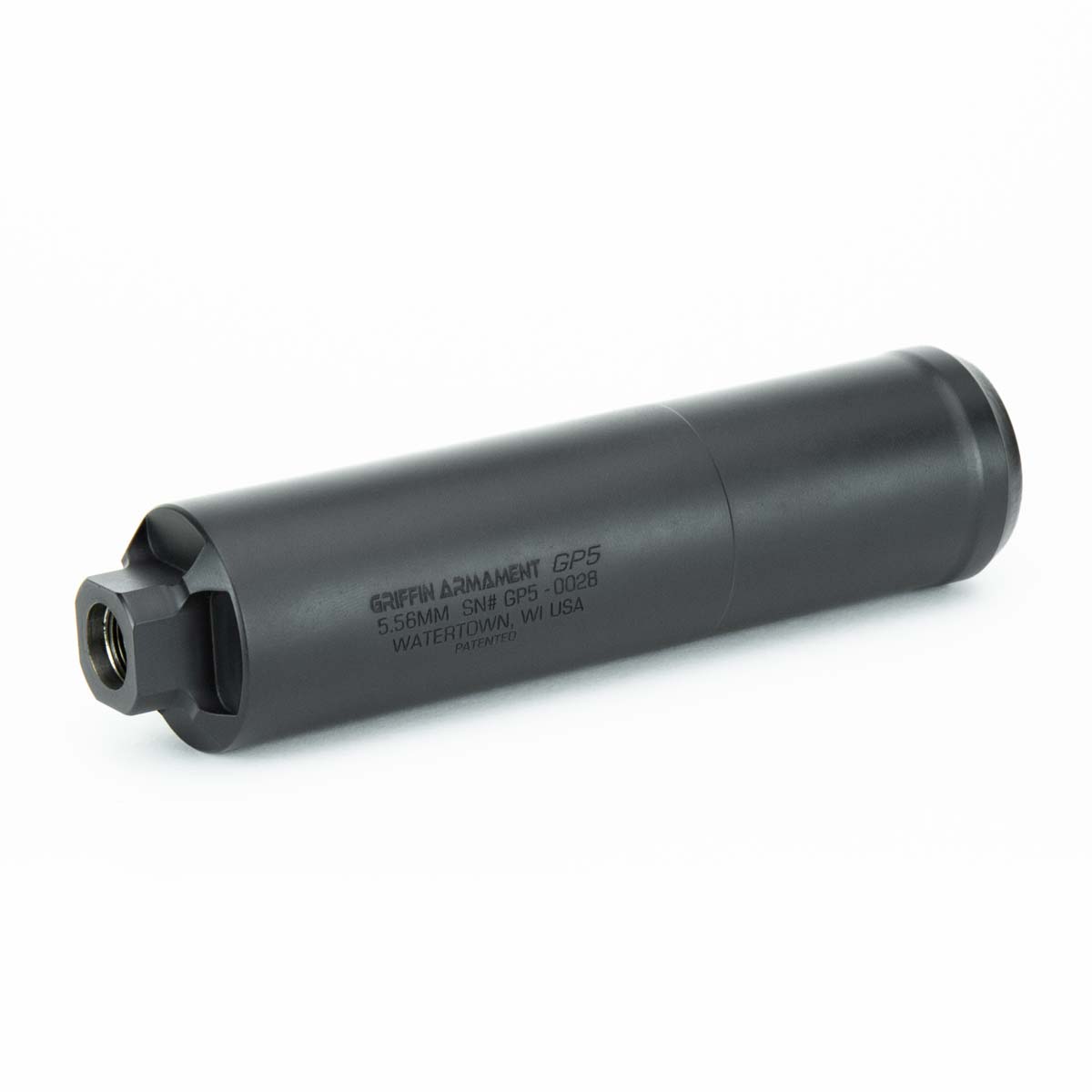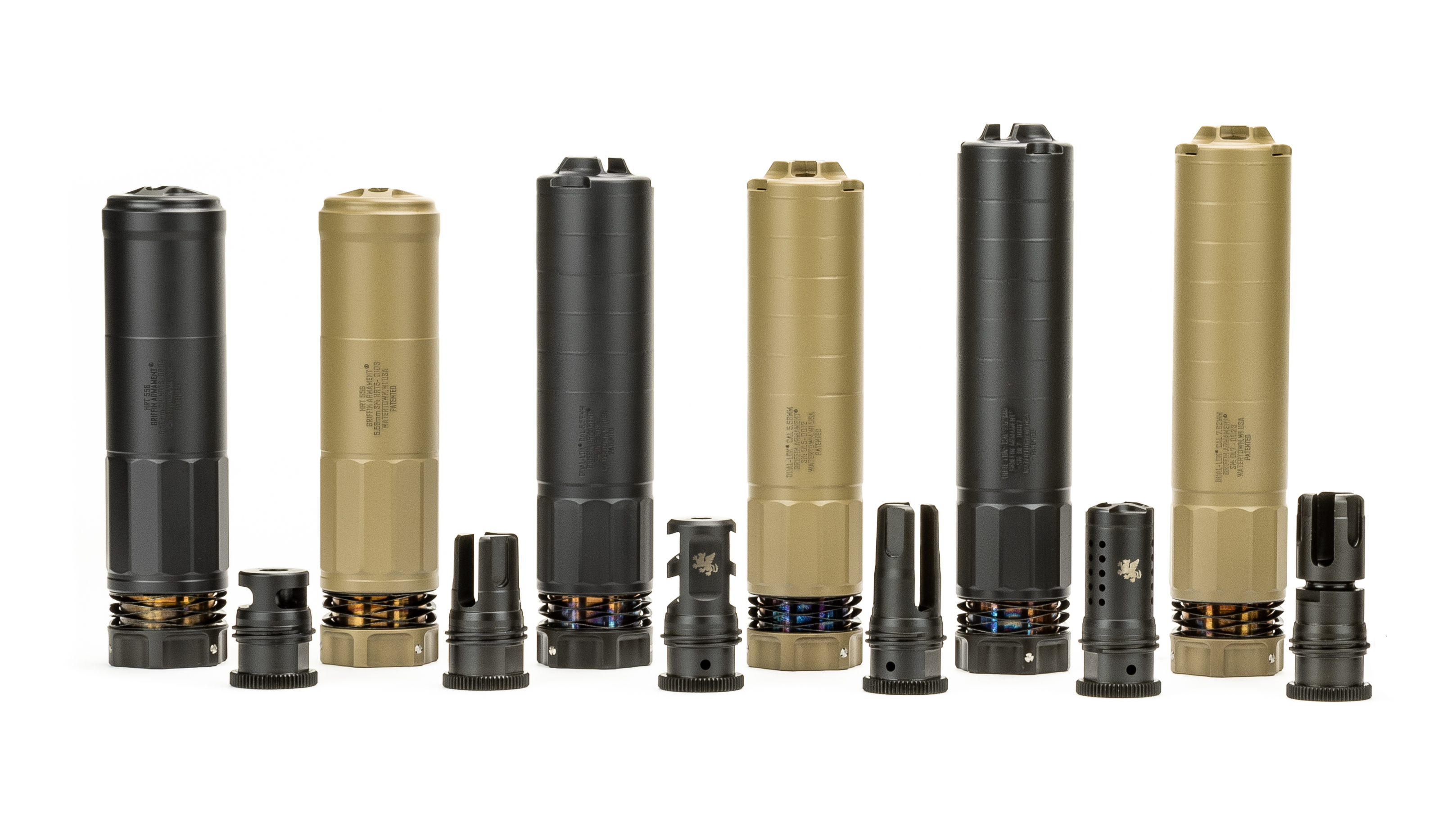Choosing a suppressor is a daunting task. Deciphering what you need for your application versus what you are being sold is hard to digest. Trustable data and information are also hard to find within the flashy marketing from the firearm industry. The purpose of the Choosing a Suppressor Series is to help you make the most informed purchasing decision possible. Which will result in the most satisfaction from the end user (YOU). I will be referencing Griffin Armament suppressors and accessories. However, these concepts are not exclusive to our product line and can be applied to nearly every manufacturer’s product. I hope you enjoy.
Mounting System
Let’s start out by defining what we are going to talk about today. Mounting system. A mounting system, in the world of suppressors, is the way by which a suppressor is attached to a firearm. There are four main types of mounting systems, direct thread, passive locking, active locking, and a combination of both passive and active locking. Each system has its own benefits and drawbacks. The correct one for you all depends on your application, firearm requirements, and general preferences.
Direct Thread
Direct thread is just as easy as it sounds. The suppressor is directly threaded onto your firearm. The suppressor is secured only by the tension / compression of a 90-degree shoulder. This compression is achieved by installing the suppressor to a manufacturer’s specified torque setting.
Side note: Some barrels come with tapered shoulders. Those sort of defeat the purpose of using direct thread and a tapered surface for a mounting system.
The main draw to direct thread is that it is very simple and cost effective. Just thread it on, tighten it down to spec, and go! Most dedicated direct thread suppressors come in at a lower price point too. Fully welded direct thread suppressors, like our GP5 and GP7, also have the side benefit of being able to “pin and weld” onto a barrel to reach the magical 16” overall barrel length. The last and more fringe “pro” to direct thread is that some precision shooters believe that direct thread is the best way to limit tolerance stacking and to increase accuracy when suppressors are used.
It seems like there are a few more drawbacks with the direct thread. The drawbacks to direct thread are that if you ever want to remove the suppressor, if you had it properly installed, you will need to use a wrench and a vise to remove it. The torque levels needed for installation can not be reliably achieved by using your hands and brute force. The second is that if the suppressor is removed, you do not have any muzzle device that functions as a flash hider, muzzle break, linear compensator, thread protector, ETC. Direct thread is also not quick attach or quick detach. If you try to install a direct thread suppressor in a rush, you may damage the threads on your barrel or suppressor. The last drawback I should mention, especially because it is common in pistol suppressors is that direct thread tends to loosen over time. This unannounced loosening can dramatically decrease accuracy and can lead to a baffle strike. Not good.
Examples
1.375x24 HUB Direct Thread Adapter
Passive Locking
Passive locking mounting system can be considered an evolution of a direct thread. Passive locking systems feature a tapered surface accompanied by some type of threads. The function of a tapered surface is best described as one of those carnival Chinese finger trap contraptions. Easy and minimal force to put on but requires more force to remove. If the suppressor has a tapered surface, it will require approximately 1.5 times the torque that was used to install the suppressor to remove the suppressor.
The tapered surface immediately resolves one of the main drawbacks to direct thread, which was not being able to quickly attach and detach the suppressor in the field. It also resolves the major concern of the suppressor backing off or becoming loose. Once you tighten down the suppressor and feel the tapered surfaces engaged, it is locked in and ready to rumble. It also gives you a plethora of different muzzle devices and thread pitches to choose from.
Since passive locking mounting systems have no moving parts and do not solely rely on thread engagement, passive locking suppressors tend to be lighter and more compact on average.
There is one drawback to passive locking systems that I do want to mention. It is difficult to visually identify whether the suppressor is installed properly. This is a consideration that most government agencies consider but for the average consumer, it is not a major issue. A simple way to alleviate this drawback is to install your suppressor to proper tightness and then witness mark the muzzle device/barrel to the suppressor. That way you can identify that if the witness mark is lined up, the suppressor is properly installed.
Examples
Plan A Mount Adapters
Optimus Micro Taper Mount Interface
Paladin® (serviceable) Silencers
Sportsman Ultra-Light (Hunting) Silencers
Active locking
Active locking systems are an old standby for mounting suppressors. For this mounting system, it will have a defined locked and unlocked position. The suppressor will interface with a muzzle device and will require a sequence of actions to lock the the suppressor.
Side Note: Most people think that ratcheting mounting systems are active locking, but they are most likely passive locking mounting systems in disguise. Looking at you Dead Air KeyMo.
What active locking has over the other styles is that it can be visually identified as locked in place. Since active locking systems do not rely on threads to interface with the muzzle device, the user can simply feel the mounting system or give the silencer a quick twist to confirm it is locked in place. This is especially useful if the firearm is being used with night vision, where items in arms reach are extremely blurred, or in a low light situation. This style of mounting system is also one of the quickest to attach and detach the suppressor to the firearm.
With pros comes cons. With more moving parts, active locking systems tend to add length and weight to a suppressor. Also, since active locking systems do not rely on thread engagement to hold the suppressor, some users do not see them as a precise way to mount a suppressor. Most active locking systems have some degree of rotational play once installed.
Examples
Combination: Active and Passive Locking
You guessed it! This one is a combination of both the mounting systems. This option is rare in the current suppressor market. Most ratchet or combination locking systems are either just passive or just active locking. For example, the Dead Air KeyMo system and YHM Phantom QD mounts. At their core, they have a thread and a tapered surface. The ratcheting system wears down over time and does not aid in security of the suppressor. Another example, the Surefire SOCOM mounting system has a locking collar that secures the suppressor to the muzzle device but the tapered surface in the system is only for alignment of the suppressor. Rugged Suppressor’s rifle mounting system comes close, but it is just two passive locking tapers. A true combination will have a passive locking and active locking system that are not reliant on each other to secure the suppressor. To my knowledge, only our DUAL-LOK™ mounting system fits in that category.
DUAL-LOK™ has all the benefits with one small drawback that I will cover shortly. Since Dual-LOK has a tapered surface and acme threads, you retain accuracy, quick detach, simplicity, and strength that comes with a passive locking system. The rear of the DUAL-LOK™ mount features a locking collar that will hold it secure under full auto fire, even if the suppressor is not tightened onto the taper. This adds the benefits of active locking systems that we went over. It can be visually and physically identified as installed correctly. As well as having a defined locked and unlocked position. Since there is a tapered surface in the muzzle device, there is no rotational play. DUAL-LOK™ also does not have any ratcheting or wear prone parts.
The only “con” I can think of with this mounting system is that since it has an active locking system, by nature, it will add a little more length and weight to the suppressor. For example, the EXPLORR® ET2 suppressor, a passive locking only suppressor featuring our Taper Mount system, is 9.0 Ounces and 6.0” long. The DUAL-LOK™5 suppressor is 11.8 Ounces and 6.5” long. I think the added 2.8OZ and 0.5” is well worth it for the DUAL-LOK™ mounting system. That’s why I have a DUAL-LOK™ 5 currently in ATF Jail.
Examples
A2S-QD (A2 attachable) Silencer
About the Author
The article was written by Jack Rapala. Jack is a USPSA carry optics shooter, night vision enthusiast, firearm salesman, suppressor connoisseur, and a customer service representative for Griffin Armament.

